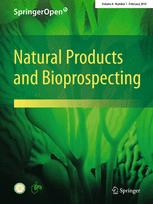|
|
Cucurbitane triterpenoids from Hemsleya penxianensis
Collect
Jian-Chao CHEN, Lin ZHOU, Yun-Hua WANG, Ren-Rong TIAN, Yun-Xin YAN, Yin NIAN, Yun SUN, Yong-Tang ZHENG, Ming-Hua QIU
Natural Products and Bioprospecting. 2012, 2 (4): 138-144.
DOI: 10.1007/s13659-011-0044-2
Two new cucurbitacins, jinfushanencins A(1) and B(2), seven new cucurbitane glycosides, jinfushanosides E-K(3-9), along with nine known analogues, were obtained from the tubers of Hemsleya penxianensis. Their structures were elucidated on the basis of extensive spectroscopic and chemical methods. Selected isolates were tested their anti-HIV-1 activities, and compound 5 showed weak anti-HIV-1 in C8166 cell(EC50=5.9 μg/mL) with a selectivity index of 13.5.
References |
Related Articles |
Metrics
|
|
|
Five new mexicanolide type limonoids from Heynea trijuga
Collect
Wei YANG, Ling-Mei KONG, Shi-Fei LI, Yan LI, Yu ZHANG, Hong-Ping HE, Xiao-Jiang HAO
Natural Products and Bioprospecting. 2012, 2 (4): 145-149.
DOI: 10.1007/s13659-012-0040-1
Five new mexicanolide-type limonoids, heytrijunolides A-E(1-5) were isolated from the branches and leaves of Heynea trijuga. The structures of these new compounds were elucidated on the basis of extensive spectroscopic analysis. Compound 3 showed weak cytotoxicity against HL-60, SMMC-7721 and A-549 human tumor cell lines with the IC50 values of 21.88, 20.66 and 12.70 μM, respectively.
References |
Related Articles |
Metrics
|
|
|
Two new glucosides from the pellicle of the walnut (Juglans regia)
Collect
Le CAI, Chuan-Shui LIU, Xiao-Wei FU, Xiao-Jing SHEN, Tian-Peng YIN, Ya-Bin YANG, Zhong-Tao DING
Natural Products and Bioprospecting. 2012, 2 (4): 150-153.
DOI: 10.1007/s13659-012-0009-0
A new α-tetralonyl glucoside, 6'-O-acetyl-juglanoside E(1), and a new dihydrophaseic acid glucoside, dihydrophaseic acid 1-O-(6-O-acetyl)-glucopyranoside(2), together with two known ones, juglanoside E(3) and dihydrophaseic acid(4), were isolated from the pellicle of the walnut(Juglans regia). The structures of the new compounds were elucidated by comprehensive spectroscopic analysis, including IR, HRESIMS, 1D and 2D NMR data.
References |
Related Articles |
Metrics
|
|
|
Three new triterpenoids from Rubia schumanniana
Collect
Bin KUANG, Jing HAN, Guang-Zhi ZENG, Xiao-Qiang CHEN, Wen-Jun HE, Ning-Hua TAN
Natural Products and Bioprospecting. 2012, 2 (4): 166-169.
DOI: 10.1007/s13659-012-0038-8
Three new triterpenoids, 3β-hydroxy-urs-30-p-Z-hydroxycinnamoyl-12-en-28-oic-acid(1), 3β-hydroxy-olean-30-p-E-hydroxycinnamoyl-12-en-28-oic-acid(2) and 3β, 6α-dihydroxy-urs-14-en-12-one(3), together with seven known triterpenoids, were isolated from the roots of Rubia schumanniana. Their structures were established by means of spectroscopic analysis. All compounds were evaluated for cytotoxic activity, and compounds 2-6 showed cytotoxicity with the IC50 values of 10.75~18.87 μg/mL.
References |
Related Articles |
Metrics
|
|
|
Five new polyketides from the basidiomycete Craterellus odoratus
Collect
Hua GUO, Tao FENG, Zheng-Hui LI, Ji-Kai LIU
Natural Products and Bioprospecting. 2012, 2 (4): 170-173.
DOI: 10.1007/s13659-012-0057-5
Five new polyketides, craterellones A-E(1-5), were isolated from cultures of basidiomycete Craterellus odoratus, together with five known compounds(6-10). Structures of 1-5 were elucidated on the basis of extensive spectroscopic analysis. All compounds were evaluated for their inhibitory activities against one isozyme of 11β-hydroxysteroid dehydrogenase(11β-HSD1) and cytotoxic activities on five tumor cell lines. Compound 10 exhibited significant cytotoxicity against HL-60, SMMC-7721, A-549, MCF-7, and SW-480, with IC50 values of 0.50, 0.69, 0.64, 1.10, 0.54 μM, respectively.
References |
Related Articles |
Metrics
|
|

